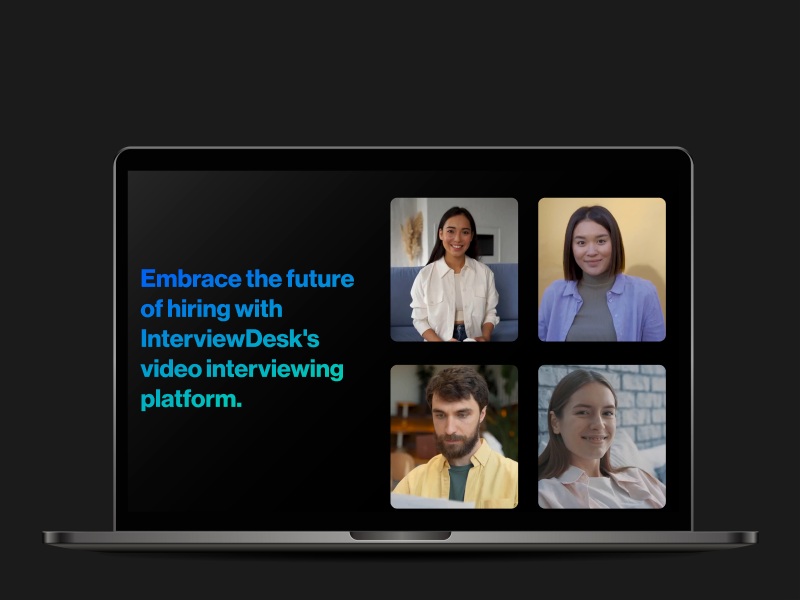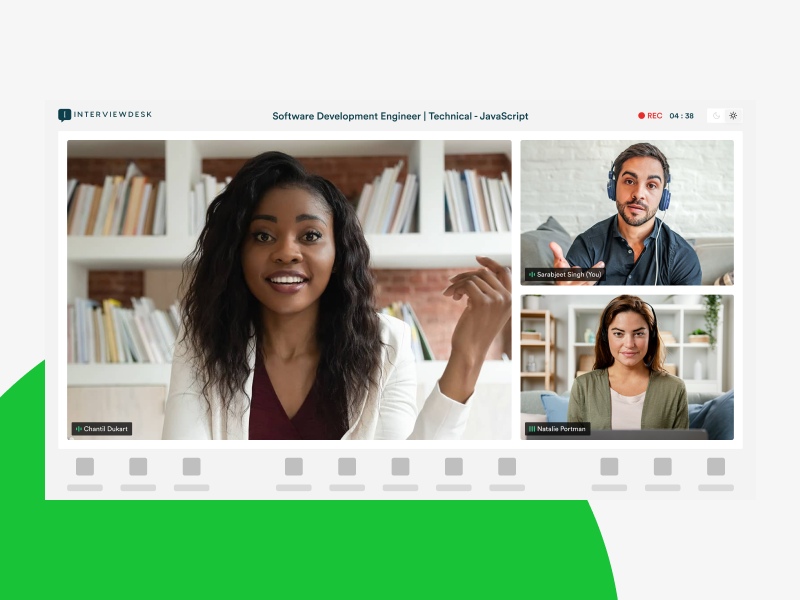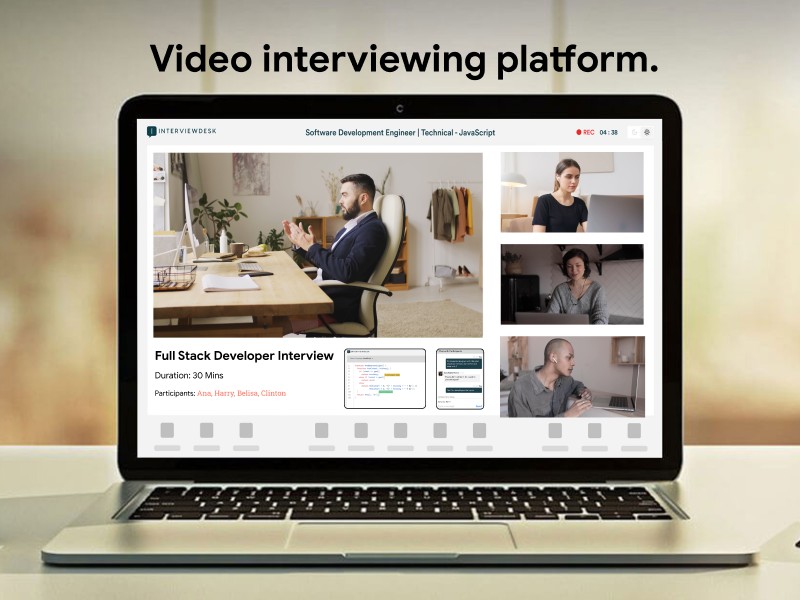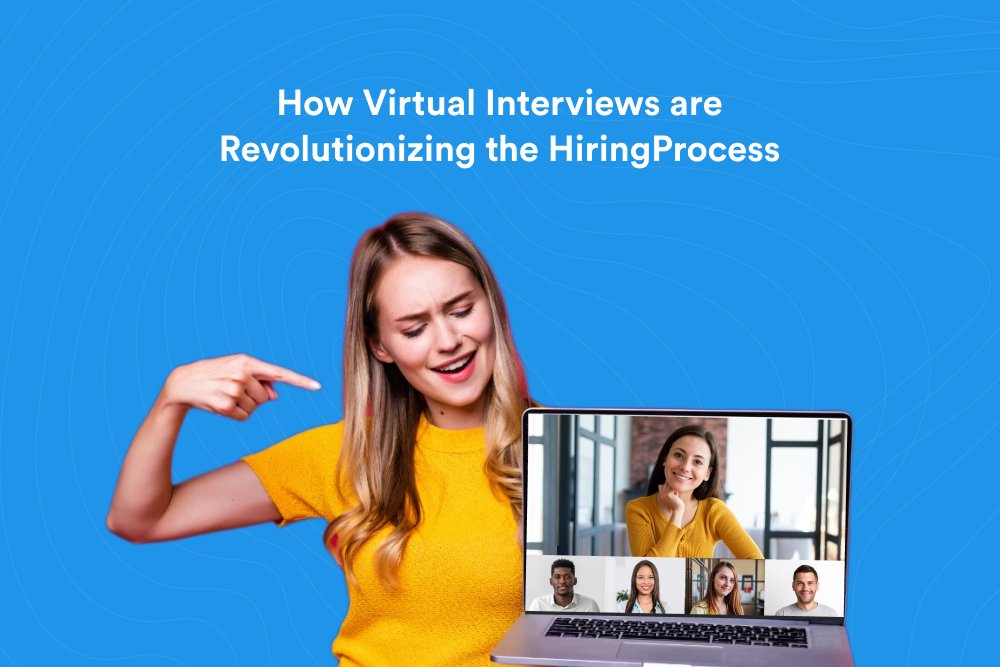Technology is still changing and transforming a number of facets of our life in today’s fast-paced digital environment. One area that has undergone a significant revolution is the hiring process. In the past, candidates and employers interacted in-person during job interviews.
Virtual interviews, however, have become a game-changer in the recruitment sector thanks to technological improvements, making the hiring process more effective, convenient, and inclusive.
Understanding the Shift to Virtual Interviews
In recent years, virtual interviews have become extremely popular. This expansion has been facilitated by a number of causes. One key factor is the increasing globalization of businesses. Candidates no longer need to travel far for an initial interview because businesses may now access talent from all around the world.
With the help of this innovative strategy, organizations may access a larger talent pool while also saving time and money.

When it comes to virtual interviews, there are various types of technologies and methods that employers can utilize. Employers and candidates may interact face-to-face regardless of their geographical locations thanks to the widespread use of video conferencing solutions in the hiring process. This has made the hiring process more flexible and accessible, breaking down geographical barriers and enabling companies to reach candidates across the globe.
Additionally, phone calls have also become a popular method for conducting virtual interviews. With the advancements in telecommunications, employers can easily connect with candidates and assess their suitability for the role without the need for in-person meetings. In addition to saving time, this improves the effectiveness of the hiring process.
The Rise of Virtual Interviews
Gone are the days when job interviews meant dressing up in formal attire and sitting across a desk from an interviewer. With the rise of virtual interviews, the hiring landscape has undergone a dramatic shift. Companies assert that interviews can now be performed by video conference, the phone, or even virtual reality. This shift has made the hiring process more flexible and accessible, breaking down geographical barriers and enabling companies to reach candidates across the globe.
The use of virtual reality technologies in the employment process has also begun. With VR headsets and immersive environments, employers can create simulated scenarios to assess candidates’ skills and suitability for the role. This innovative approach not only provides a unique experience for candidates but also allows employers to gauge their potential in a more interactive and engaging manner.
The Role of Technology in Hiring
Technology has played a pivotal role in driving the adoption of virtual interviews. Even if they are thousands of miles distant, employers may readily meet with candidates in-person thanks to the plethora of video conferencing platforms and collaboration tools. This has not only saved companies significant travel costs but has also opened up opportunities for candidates who may not have been able to attend in-person interviews due to various constraints.

The first screening process has also been transformed by artificial intelligence (AI), with chatbots powered by AI capable of conducting automated interviews and evaluating candidates’ qualifications for the position. These chatbots can ask tailored questions, analyse responses, and provide instant feedback, allowing employers to efficiently screen a large number of candidates in a short amount of time. Only the most eligible applicants move on in the selection phase, which streamlines the employment process further.
In conclusion, the shift to virtual interviews has brought about significant changes in the hiring landscape. Virtual interviews have evolved into a practical and effective means for employers to engage with candidates from all over the world as a result of the increasing globalization of business and technological improvements.
The Benefits of Virtual Interviews
Virtual interviews bring a myriad of advantages to both employers and job seekers. Organisations can streamline their hiring procedures and increase efficiency by adopting this innovative strategy.
But what exactly are the benefits of virtual interviews? Let’s delve more deeply into this subject and examine the benefits in greater depth.
Saving Time and Resources
The huge decrease in time and resources needed for the employment process is one of the most important advantages of virtual interviews. With traditional interviews, employers had to allocate substantial time and resources for scheduling, logistics, and travel expenses. However, with virtual interviews, these obstacles are eliminated, allowing companies to expedite the hiring process and make quicker decisions.
Imagine the time saved by not having to coordinate the schedules of multiple interviewers and candidates, or the money saved on travel expenses. virtual interviews offer a more effective and economical alternative, enabling companies to concentrate their efforts on other crucial elements of the hiring process.
Expanding the Talent Pool
Virtual interviews break down geographical barriers, offering organizations the opportunity to access talent from around the world. This expanded reach means that companies are no longer limited to local candidates, opening up the possibility of hiring exceptional individuals with diverse backgrounds and expertise.
Think about the possibilities that arise when companies can tap into a global talent pool. They can locate applicants with distinctive abilities, viewpoints, and experiences who can advance the development and success of their company. Virtual interviews provide a platform for connecting with top talent, regardless of their location.
Increasing Flexibility for Candidates and Employers
Virtual interviews provide a level of flexibility that traditional interviews cannot match. Candidates can attend interviews from the convenience of their homes, sparing them the stress and expense of making travel arrangements. Likewise, employers can schedule interviews more conveniently, accommodating the busy schedules of both parties.
Imagine a candidate who is currently employed and has limited availability during regular working hours. With virtual interviews, they can easily schedule an interview outside of their working hours, ensuring that they can participate without any conflicts. This flexibility allows for a smoother interview experience and ensures that candidates and employers can focus on what really matters – assessing skills and fit for the role.
In conclusion, virtual interviews offer numerous benefits to both employers and job seekers. They save time and resources, expand the talent pool, and increase flexibility for all parties involved. Virtual interviews are becoming more common in the employment process as technology develops, revolutionising how businesses find and hire top talent.
How Virtual Interviews Work
Let’s explore the mechanics of virtual interviews now that we are aware of their benefits. From the types of virtual interviews to the necessary preparations, here’s everything you need to know about this modern approach to hiring.
The employment process has been revolutionised by the use of virtual interviews, which have increased convenience and accessibility for both companies and candidates.
Virtual interviews are becoming more and more popular as a result of technological advancements, allowing people to connect and participate in interviews from the convenience of their own homes or offices.
The Different Types of Virtual Interviews
Virtual interviews are becoming more and more popular as a result of technological advancements, allowing people to connect and participate in interviews from the convenience of their own homes or offices. Video interviews, for example, are the most common type, allowing candidates and employers to engage in face-to-face conversations remotely. Through video conferencing platforms, such as Zoom or Skype, candidates can showcase their communication skills, body language, and overall presentation. This type of virtual interview provides a more personal touch, giving candidates the opportunity to make a lasting impression.
Phone interviews offer a more traditional approach, relying solely on verbal communication. Although there may be limitations in terms of non-verbal cues, phone interviews still allow candidates to effectively express their qualifications and enthusiasm for the position. In a phone interview, it’s crucial to pay attention to your voice tone and express yourself effectively.
In some cases, companies even opt for virtual reality interviews, where candidates can showcase their skills in simulated work scenarios. This innovative approach allows employers to assess a candidate’s problem-solving abilities, adaptability, and creativity in a virtual environment. Virtual reality interviews provide a unique and immersive experience, giving candidates an opportunity to stand out from the competition.
Understanding these different types of virtual interviews will help you better prepare for the specific format you will encounter. To ensure a flawless experience during the interview, it’s critical to become familiar with the technology and tools being used.
Preparing for a Virtual Interview
To ensure a successful virtual interview, adequate preparation is key. Just like traditional interviews, you should research the company, familiarize yourself with the job description, and anticipate common interview questions. However, it is essential to check your internet connection, make sure your camera and microphone are
working properly, and to set up a distraction-free environment during the virtual interview.
Testing your internet connection is crucial to avoid any technical difficulties during the interview. A stable and reliable internet connection will ensure that the interview proceeds smoothly without any disruptions. To make sure your camera and microphone are working properly, it is advised to hold a test call or video conference with a friend or member of your family.
Creating a distraction-free environment is essential to maintain focus and professionalism during the interview. Locate a place that is peaceful, well-lit, and where you may sit comfortably with few distractions. Make sure to inform your household members or colleagues about your interview schedule to avoid any unexpected disturbances.
You’ll feel more assured and leave a good impression on your future job if you come prepared. Practice your responses to common interview questions, rehearse your elevator pitch, and have relevant examples ready to showcase your skills and experiences.

Conducting a Successful Virtual Interview
Comparing virtual interviews to in-person ones requires a somewhat different strategy. It’s important to keep eye contact with the interviewer by gazing directly into the camera, as this creates the impression that you’re doing so. This can be challenging at first, as our natural inclination is to look at the screen or our own reflection. However, by focusing on the camera, you will create a more engaging and personal connection with the interviewer.
Additionally, actively listening and engaging in the conversation is essential to show your genuine interest in the role. Spend time paying close attention to the interviewer’s queries and offering well-considered responses. Show enthusiasm and ask relevant questions to demonstrate your curiosity and eagerness to learn more about the company and the position.
Pay attention to your body language and maintain a professional and confident demeanour throughout the interview. Sit up straight, smile, and use hand gestures appropriately to convey your message effectively. Dress professionally, just as you would for an in-person interview, to create a positive first impression.
By adapting to the virtual environment, you can ensure a successful interview experience. Embrace the technology, be prepared, and showcase your skills and qualifications with confidence. The hiring process now includes a significant amount of virtual interviews, so if you can master this cutting-edge tactic, your chances of landing your dream job will rise.
Challenges and Solutions in Virtual Interviews
While virtual interviews have revolutionized the hiring process, they are not without their challenges. It is important for both candidates and employers to be aware of these challenges and find solutions to ensure a seamless virtual interview experience.
Overcoming Technical Difficulties
Technical difficulties are a common concern when it comes to virtual interviews. Poor internet connections, audio or video malfunctions, and software glitches can disrupt the flow of an interview. To mitigate these challenges, it’s important to test your equipment in advance, have a backup plan in case of technical issues, and communicate with the interviewer to find alternative methods of communication if needed. Being prepared and proactive will allow you to navigate any technical difficulties that may arise.
Ensuring Effective Communication
One potential drawback of virtual interviews is the potential for miscommunication or misinterpretation. Hold a test call or video conference with a friend or member of your family to ensure your camera and microphone are functioning properly. To overcome this challenge, candidates and employers must focus on clear and concise communication. Speak slowly, articulate your words, and be conscious of your body language. Similarly, active listening plays a crucial role in understanding the interviewer’s questions and providing thoughtful responses. By enhancing communication skills, virtual interviews can be just as effective as in-person ones.
Maintaining Professionalism in a Virtual Setting
A final challenge in virtual interviews is maintaining professionalism in a digital environment. Even though the environment may be different, you should still approach a virtual interview with the same professionalism you would bring to an in-person interview. Dress appropriately, maintain good posture, and ensure that your surroundings are clean and organized. Remember, first impressions are equally important in a virtual setting, so present yourself in a professional manner to leave a lasting positive impact on your potential employer.
Conclusion
Virtual interviews have ushered in a new era of hiring, offering numerous benefits for both employers and candidates. The shift to virtual interviews has revolutionized the recruitment process, making it more efficient, convenient, and inclusive. By understanding the different types of virtual interviews, preparing adequately, and overcoming the challenges associated with this new approach, candidates can position themselves for success in an increasingly digital job market. Virtual interviews are expected to become a standard component of the hiring process as technology develops, presenting opportunities for both employers and job seekers.










